Business Environment Analysis Report: Tesco's SWOT and PESTLE Analysis
VerifiedAdded on 2023/01/12
|12
|3864
|58
Report
AI Summary
This report provides a comprehensive analysis of Tesco's business environment, examining the influence of both economic and non-economic factors on its operations. The introduction outlines Tesco's global presence as a leading multinational grocery retailer and its diversification into various product and service sectors. The literature review delves into the impact of economic elements such as inflation, tax rates, and unemployment, as well as non-economic factors including socio-cultural aspects, technological advancements, and demographic shifts. The report further employs SWOT and PESTLE analyses to assess Tesco's strengths, weaknesses, opportunities, and threats, along with the political, economic, social, technological, legal, and environmental factors impacting the company. The analysis highlights the challenges and opportunities Tesco faces within the competitive retail market, providing insights into its strategic positioning and future prospects.
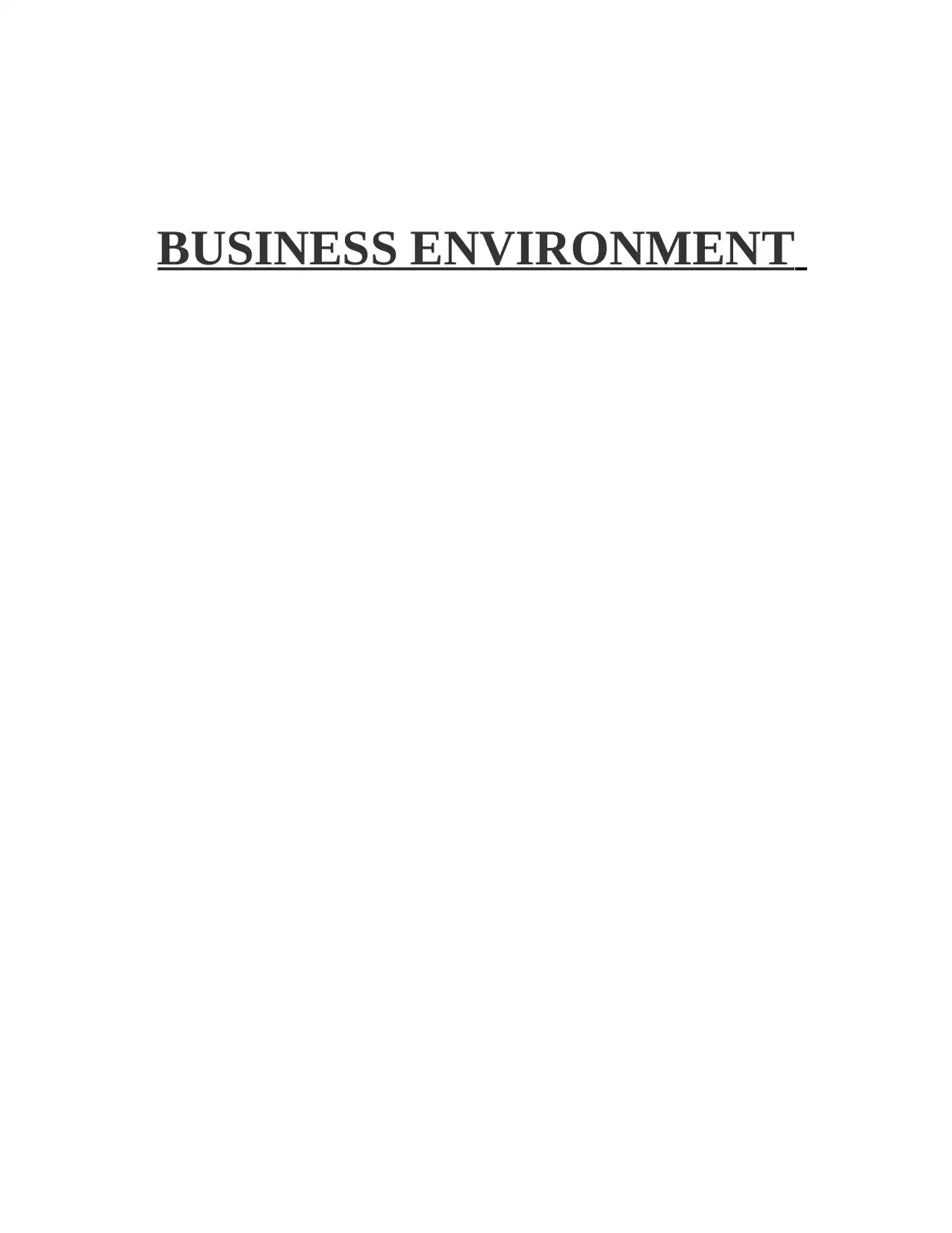
BUSINESS ENVIRONMENT
Paraphrase This Document
Need a fresh take? Get an instant paraphrase of this document with our AI Paraphraser
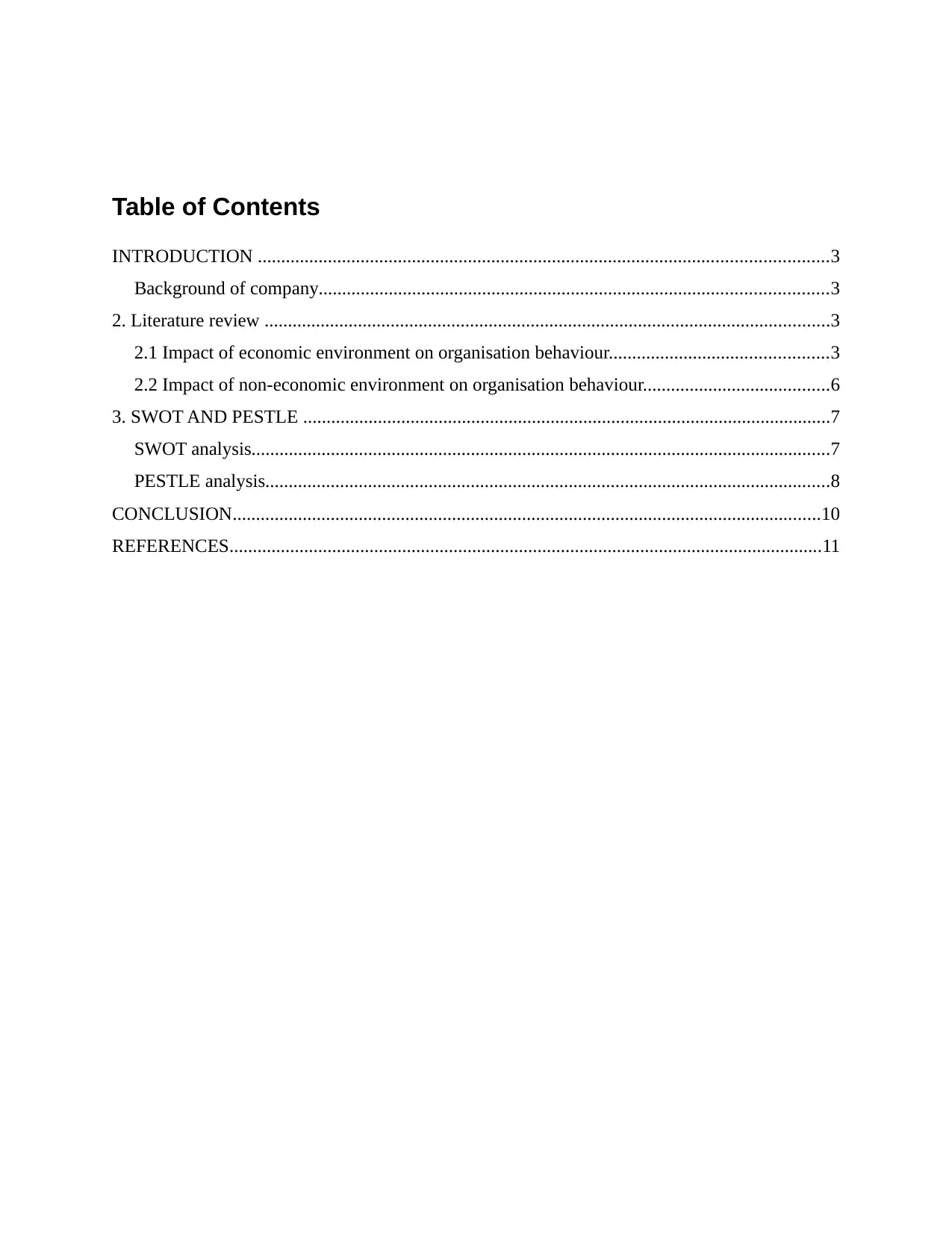
Table of Contents
INTRODUCTION ..........................................................................................................................3
Background of company.............................................................................................................3
2. Literature review .........................................................................................................................3
2.1 Impact of economic environment on organisation behaviour...............................................3
2.2 Impact of non-economic environment on organisation behaviour........................................6
3. SWOT AND PESTLE .................................................................................................................7
SWOT analysis............................................................................................................................7
PESTLE analysis.........................................................................................................................8
CONCLUSION..............................................................................................................................10
REFERENCES...............................................................................................................................11
INTRODUCTION ..........................................................................................................................3
Background of company.............................................................................................................3
2. Literature review .........................................................................................................................3
2.1 Impact of economic environment on organisation behaviour...............................................3
2.2 Impact of non-economic environment on organisation behaviour........................................6
3. SWOT AND PESTLE .................................................................................................................7
SWOT analysis............................................................................................................................7
PESTLE analysis.........................................................................................................................8
CONCLUSION..............................................................................................................................10
REFERENCES...............................................................................................................................11
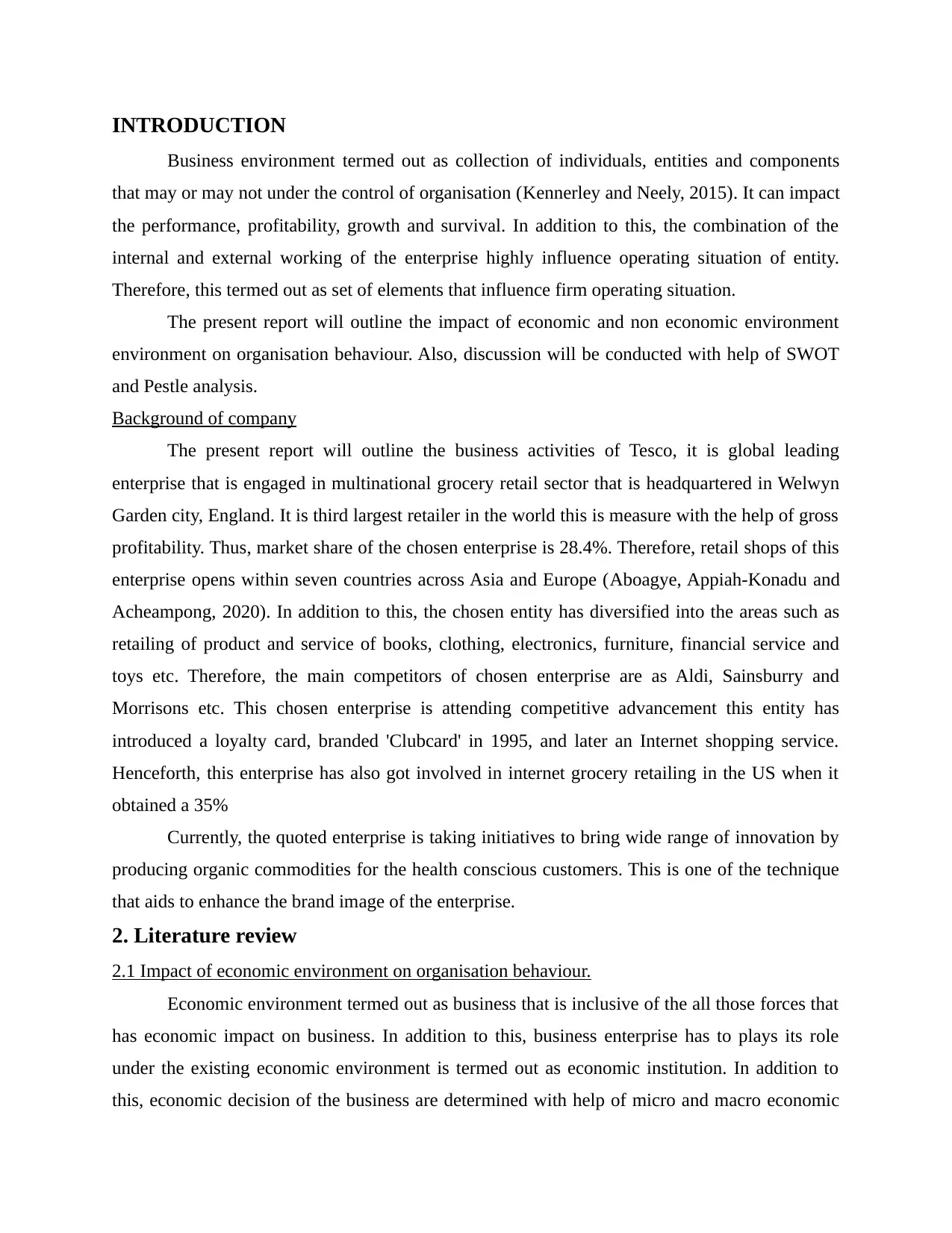
INTRODUCTION
Business environment termed out as collection of individuals, entities and components
that may or may not under the control of organisation (Kennerley and Neely, 2015). It can impact
the performance, profitability, growth and survival. In addition to this, the combination of the
internal and external working of the enterprise highly influence operating situation of entity.
Therefore, this termed out as set of elements that influence firm operating situation.
The present report will outline the impact of economic and non economic environment
environment on organisation behaviour. Also, discussion will be conducted with help of SWOT
and Pestle analysis.
Background of company
The present report will outline the business activities of Tesco, it is global leading
enterprise that is engaged in multinational grocery retail sector that is headquartered in Welwyn
Garden city, England. It is third largest retailer in the world this is measure with the help of gross
profitability. Thus, market share of the chosen enterprise is 28.4%. Therefore, retail shops of this
enterprise opens within seven countries across Asia and Europe (Aboagye, Appiah-Konadu and
Acheampong, 2020). In addition to this, the chosen entity has diversified into the areas such as
retailing of product and service of books, clothing, electronics, furniture, financial service and
toys etc. Therefore, the main competitors of chosen enterprise are as Aldi, Sainsburry and
Morrisons etc. This chosen enterprise is attending competitive advancement this entity has
introduced a loyalty card, branded 'Clubcard' in 1995, and later an Internet shopping service.
Henceforth, this enterprise has also got involved in internet grocery retailing in the US when it
obtained a 35%
Currently, the quoted enterprise is taking initiatives to bring wide range of innovation by
producing organic commodities for the health conscious customers. This is one of the technique
that aids to enhance the brand image of the enterprise.
2. Literature review
2.1 Impact of economic environment on organisation behaviour.
Economic environment termed out as business that is inclusive of the all those forces that
has economic impact on business. In addition to this, business enterprise has to plays its role
under the existing economic environment is termed out as economic institution. In addition to
this, economic decision of the business are determined with help of micro and macro economic
Business environment termed out as collection of individuals, entities and components
that may or may not under the control of organisation (Kennerley and Neely, 2015). It can impact
the performance, profitability, growth and survival. In addition to this, the combination of the
internal and external working of the enterprise highly influence operating situation of entity.
Therefore, this termed out as set of elements that influence firm operating situation.
The present report will outline the impact of economic and non economic environment
environment on organisation behaviour. Also, discussion will be conducted with help of SWOT
and Pestle analysis.
Background of company
The present report will outline the business activities of Tesco, it is global leading
enterprise that is engaged in multinational grocery retail sector that is headquartered in Welwyn
Garden city, England. It is third largest retailer in the world this is measure with the help of gross
profitability. Thus, market share of the chosen enterprise is 28.4%. Therefore, retail shops of this
enterprise opens within seven countries across Asia and Europe (Aboagye, Appiah-Konadu and
Acheampong, 2020). In addition to this, the chosen entity has diversified into the areas such as
retailing of product and service of books, clothing, electronics, furniture, financial service and
toys etc. Therefore, the main competitors of chosen enterprise are as Aldi, Sainsburry and
Morrisons etc. This chosen enterprise is attending competitive advancement this entity has
introduced a loyalty card, branded 'Clubcard' in 1995, and later an Internet shopping service.
Henceforth, this enterprise has also got involved in internet grocery retailing in the US when it
obtained a 35%
Currently, the quoted enterprise is taking initiatives to bring wide range of innovation by
producing organic commodities for the health conscious customers. This is one of the technique
that aids to enhance the brand image of the enterprise.
2. Literature review
2.1 Impact of economic environment on organisation behaviour.
Economic environment termed out as business that is inclusive of the all those forces that
has economic impact on business. In addition to this, business enterprise has to plays its role
under the existing economic environment is termed out as economic institution. In addition to
this, economic decision of the business are determined with help of micro and macro economic
⊘ This is a preview!⊘
Do you want full access?
Subscribe today to unlock all pages.

Trusted by 1+ million students worldwide
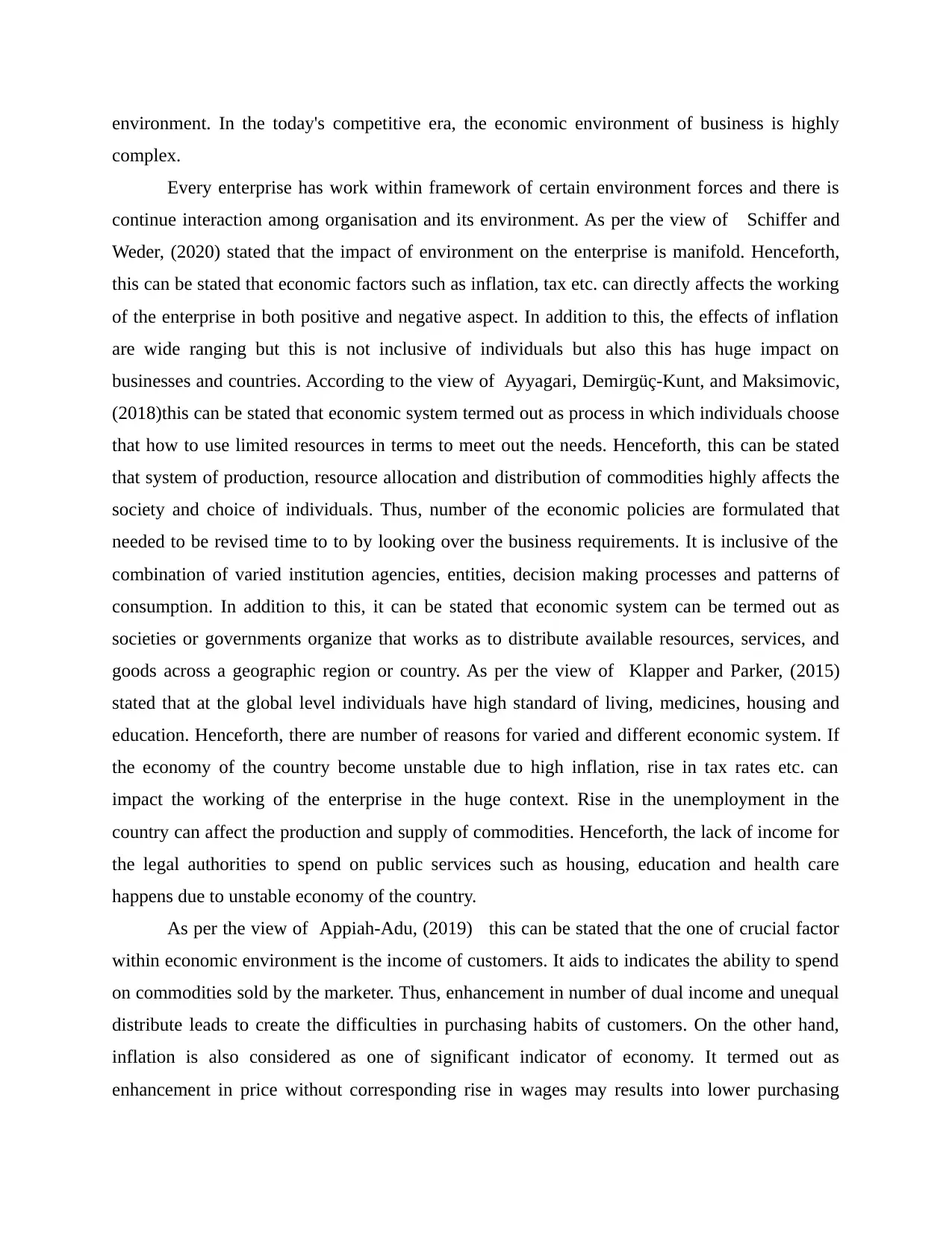
environment. In the today's competitive era, the economic environment of business is highly
complex.
Every enterprise has work within framework of certain environment forces and there is
continue interaction among organisation and its environment. As per the view of Schiffer and
Weder, (2020) stated that the impact of environment on the enterprise is manifold. Henceforth,
this can be stated that economic factors such as inflation, tax etc. can directly affects the working
of the enterprise in both positive and negative aspect. In addition to this, the effects of inflation
are wide ranging but this is not inclusive of individuals but also this has huge impact on
businesses and countries. According to the view of Ayyagari, Demirgüç-Kunt, and Maksimovic,
(2018)this can be stated that economic system termed out as process in which individuals choose
that how to use limited resources in terms to meet out the needs. Henceforth, this can be stated
that system of production, resource allocation and distribution of commodities highly affects the
society and choice of individuals. Thus, number of the economic policies are formulated that
needed to be revised time to to by looking over the business requirements. It is inclusive of the
combination of varied institution agencies, entities, decision making processes and patterns of
consumption. In addition to this, it can be stated that economic system can be termed out as
societies or governments organize that works as to distribute available resources, services, and
goods across a geographic region or country. As per the view of Klapper and Parker, (2015)
stated that at the global level individuals have high standard of living, medicines, housing and
education. Henceforth, there are number of reasons for varied and different economic system. If
the economy of the country become unstable due to high inflation, rise in tax rates etc. can
impact the working of the enterprise in the huge context. Rise in the unemployment in the
country can affect the production and supply of commodities. Henceforth, the lack of income for
the legal authorities to spend on public services such as housing, education and health care
happens due to unstable economy of the country.
As per the view of Appiah-Adu, (2019) this can be stated that the one of crucial factor
within economic environment is the income of customers. It aids to indicates the ability to spend
on commodities sold by the marketer. Thus, enhancement in number of dual income and unequal
distribute leads to create the difficulties in purchasing habits of customers. On the other hand,
inflation is also considered as one of significant indicator of economy. It termed out as
enhancement in price without corresponding rise in wages may results into lower purchasing
complex.
Every enterprise has work within framework of certain environment forces and there is
continue interaction among organisation and its environment. As per the view of Schiffer and
Weder, (2020) stated that the impact of environment on the enterprise is manifold. Henceforth,
this can be stated that economic factors such as inflation, tax etc. can directly affects the working
of the enterprise in both positive and negative aspect. In addition to this, the effects of inflation
are wide ranging but this is not inclusive of individuals but also this has huge impact on
businesses and countries. According to the view of Ayyagari, Demirgüç-Kunt, and Maksimovic,
(2018)this can be stated that economic system termed out as process in which individuals choose
that how to use limited resources in terms to meet out the needs. Henceforth, this can be stated
that system of production, resource allocation and distribution of commodities highly affects the
society and choice of individuals. Thus, number of the economic policies are formulated that
needed to be revised time to to by looking over the business requirements. It is inclusive of the
combination of varied institution agencies, entities, decision making processes and patterns of
consumption. In addition to this, it can be stated that economic system can be termed out as
societies or governments organize that works as to distribute available resources, services, and
goods across a geographic region or country. As per the view of Klapper and Parker, (2015)
stated that at the global level individuals have high standard of living, medicines, housing and
education. Henceforth, there are number of reasons for varied and different economic system. If
the economy of the country become unstable due to high inflation, rise in tax rates etc. can
impact the working of the enterprise in the huge context. Rise in the unemployment in the
country can affect the production and supply of commodities. Henceforth, the lack of income for
the legal authorities to spend on public services such as housing, education and health care
happens due to unstable economy of the country.
As per the view of Appiah-Adu, (2019) this can be stated that the one of crucial factor
within economic environment is the income of customers. It aids to indicates the ability to spend
on commodities sold by the marketer. Thus, enhancement in number of dual income and unequal
distribute leads to create the difficulties in purchasing habits of customers. On the other hand,
inflation is also considered as one of significant indicator of economy. It termed out as
enhancement in price without corresponding rise in wages may results into lower purchasing
Paraphrase This Document
Need a fresh take? Get an instant paraphrase of this document with our AI Paraphraser
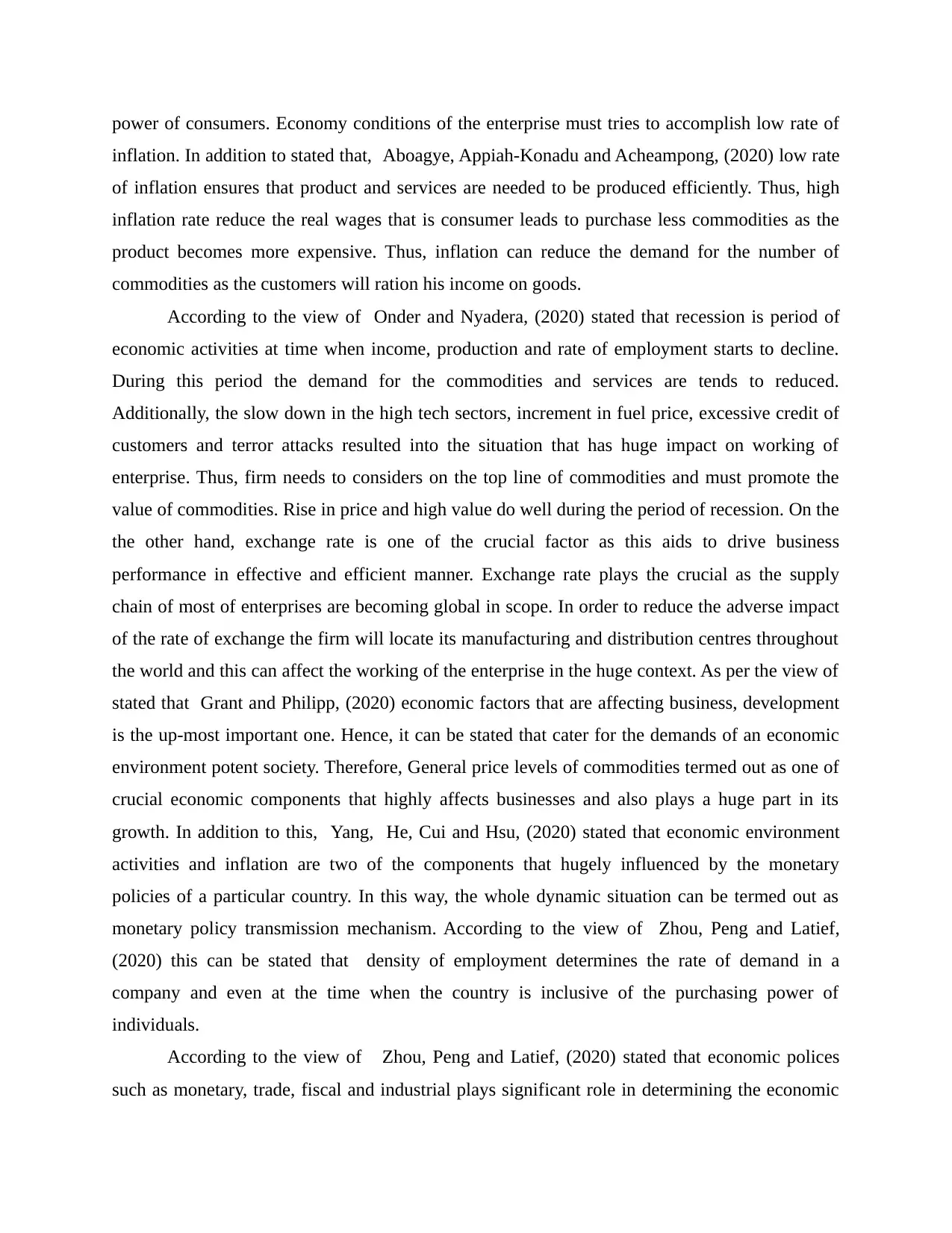
power of consumers. Economy conditions of the enterprise must tries to accomplish low rate of
inflation. In addition to stated that, Aboagye, Appiah-Konadu and Acheampong, (2020) low rate
of inflation ensures that product and services are needed to be produced efficiently. Thus, high
inflation rate reduce the real wages that is consumer leads to purchase less commodities as the
product becomes more expensive. Thus, inflation can reduce the demand for the number of
commodities as the customers will ration his income on goods.
According to the view of Onder and Nyadera, (2020) stated that recession is period of
economic activities at time when income, production and rate of employment starts to decline.
During this period the demand for the commodities and services are tends to reduced.
Additionally, the slow down in the high tech sectors, increment in fuel price, excessive credit of
customers and terror attacks resulted into the situation that has huge impact on working of
enterprise. Thus, firm needs to considers on the top line of commodities and must promote the
value of commodities. Rise in price and high value do well during the period of recession. On the
the other hand, exchange rate is one of the crucial factor as this aids to drive business
performance in effective and efficient manner. Exchange rate plays the crucial as the supply
chain of most of enterprises are becoming global in scope. In order to reduce the adverse impact
of the rate of exchange the firm will locate its manufacturing and distribution centres throughout
the world and this can affect the working of the enterprise in the huge context. As per the view of
stated that Grant and Philipp, (2020) economic factors that are affecting business, development
is the up-most important one. Hence, it can be stated that cater for the demands of an economic
environment potent society. Therefore, General price levels of commodities termed out as one of
crucial economic components that highly affects businesses and also plays a huge part in its
growth. In addition to this, Yang, He, Cui and Hsu, (2020) stated that economic environment
activities and inflation are two of the components that hugely influenced by the monetary
policies of a particular country. In this way, the whole dynamic situation can be termed out as
monetary policy transmission mechanism. According to the view of Zhou, Peng and Latief,
(2020) this can be stated that density of employment determines the rate of demand in a
company and even at the time when the country is inclusive of the purchasing power of
individuals.
According to the view of Zhou, Peng and Latief, (2020) stated that economic polices
such as monetary, trade, fiscal and industrial plays significant role in determining the economic
inflation. In addition to stated that, Aboagye, Appiah-Konadu and Acheampong, (2020) low rate
of inflation ensures that product and services are needed to be produced efficiently. Thus, high
inflation rate reduce the real wages that is consumer leads to purchase less commodities as the
product becomes more expensive. Thus, inflation can reduce the demand for the number of
commodities as the customers will ration his income on goods.
According to the view of Onder and Nyadera, (2020) stated that recession is period of
economic activities at time when income, production and rate of employment starts to decline.
During this period the demand for the commodities and services are tends to reduced.
Additionally, the slow down in the high tech sectors, increment in fuel price, excessive credit of
customers and terror attacks resulted into the situation that has huge impact on working of
enterprise. Thus, firm needs to considers on the top line of commodities and must promote the
value of commodities. Rise in price and high value do well during the period of recession. On the
the other hand, exchange rate is one of the crucial factor as this aids to drive business
performance in effective and efficient manner. Exchange rate plays the crucial as the supply
chain of most of enterprises are becoming global in scope. In order to reduce the adverse impact
of the rate of exchange the firm will locate its manufacturing and distribution centres throughout
the world and this can affect the working of the enterprise in the huge context. As per the view of
stated that Grant and Philipp, (2020) economic factors that are affecting business, development
is the up-most important one. Hence, it can be stated that cater for the demands of an economic
environment potent society. Therefore, General price levels of commodities termed out as one of
crucial economic components that highly affects businesses and also plays a huge part in its
growth. In addition to this, Yang, He, Cui and Hsu, (2020) stated that economic environment
activities and inflation are two of the components that hugely influenced by the monetary
policies of a particular country. In this way, the whole dynamic situation can be termed out as
monetary policy transmission mechanism. According to the view of Zhou, Peng and Latief,
(2020) this can be stated that density of employment determines the rate of demand in a
company and even at the time when the country is inclusive of the purchasing power of
individuals.
According to the view of Zhou, Peng and Latief, (2020) stated that economic polices
such as monetary, trade, fiscal and industrial plays significant role in determining the economic
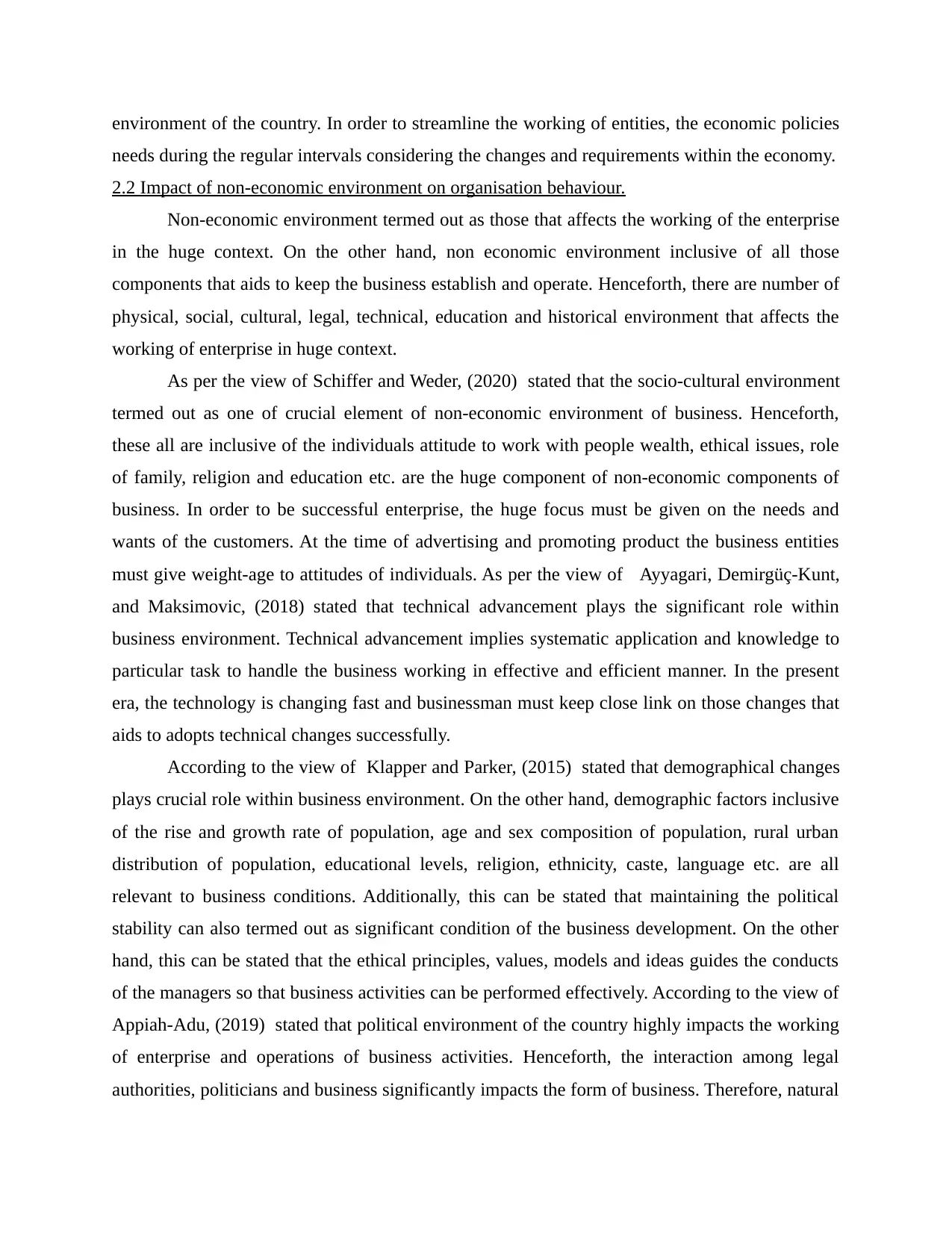
environment of the country. In order to streamline the working of entities, the economic policies
needs during the regular intervals considering the changes and requirements within the economy.
2.2 Impact of non-economic environment on organisation behaviour.
Non-economic environment termed out as those that affects the working of the enterprise
in the huge context. On the other hand, non economic environment inclusive of all those
components that aids to keep the business establish and operate. Henceforth, there are number of
physical, social, cultural, legal, technical, education and historical environment that affects the
working of enterprise in huge context.
As per the view of Schiffer and Weder, (2020) stated that the socio-cultural environment
termed out as one of crucial element of non-economic environment of business. Henceforth,
these all are inclusive of the individuals attitude to work with people wealth, ethical issues, role
of family, religion and education etc. are the huge component of non-economic components of
business. In order to be successful enterprise, the huge focus must be given on the needs and
wants of the customers. At the time of advertising and promoting product the business entities
must give weight-age to attitudes of individuals. As per the view of Ayyagari, Demirgüç-Kunt,
and Maksimovic, (2018) stated that technical advancement plays the significant role within
business environment. Technical advancement implies systematic application and knowledge to
particular task to handle the business working in effective and efficient manner. In the present
era, the technology is changing fast and businessman must keep close link on those changes that
aids to adopts technical changes successfully.
According to the view of Klapper and Parker, (2015) stated that demographical changes
plays crucial role within business environment. On the other hand, demographic factors inclusive
of the rise and growth rate of population, age and sex composition of population, rural urban
distribution of population, educational levels, religion, ethnicity, caste, language etc. are all
relevant to business conditions. Additionally, this can be stated that maintaining the political
stability can also termed out as significant condition of the business development. On the other
hand, this can be stated that the ethical principles, values, models and ideas guides the conducts
of the managers so that business activities can be performed effectively. According to the view of
Appiah-Adu, (2019) stated that political environment of the country highly impacts the working
of enterprise and operations of business activities. Henceforth, the interaction among legal
authorities, politicians and business significantly impacts the form of business. Therefore, natural
needs during the regular intervals considering the changes and requirements within the economy.
2.2 Impact of non-economic environment on organisation behaviour.
Non-economic environment termed out as those that affects the working of the enterprise
in the huge context. On the other hand, non economic environment inclusive of all those
components that aids to keep the business establish and operate. Henceforth, there are number of
physical, social, cultural, legal, technical, education and historical environment that affects the
working of enterprise in huge context.
As per the view of Schiffer and Weder, (2020) stated that the socio-cultural environment
termed out as one of crucial element of non-economic environment of business. Henceforth,
these all are inclusive of the individuals attitude to work with people wealth, ethical issues, role
of family, religion and education etc. are the huge component of non-economic components of
business. In order to be successful enterprise, the huge focus must be given on the needs and
wants of the customers. At the time of advertising and promoting product the business entities
must give weight-age to attitudes of individuals. As per the view of Ayyagari, Demirgüç-Kunt,
and Maksimovic, (2018) stated that technical advancement plays the significant role within
business environment. Technical advancement implies systematic application and knowledge to
particular task to handle the business working in effective and efficient manner. In the present
era, the technology is changing fast and businessman must keep close link on those changes that
aids to adopts technical changes successfully.
According to the view of Klapper and Parker, (2015) stated that demographical changes
plays crucial role within business environment. On the other hand, demographic factors inclusive
of the rise and growth rate of population, age and sex composition of population, rural urban
distribution of population, educational levels, religion, ethnicity, caste, language etc. are all
relevant to business conditions. Additionally, this can be stated that maintaining the political
stability can also termed out as significant condition of the business development. On the other
hand, this can be stated that the ethical principles, values, models and ideas guides the conducts
of the managers so that business activities can be performed effectively. According to the view of
Appiah-Adu, (2019) stated that political environment of the country highly impacts the working
of enterprise and operations of business activities. Henceforth, the interaction among legal
authorities, politicians and business significantly impacts the form of business. Therefore, natural
⊘ This is a preview!⊘
Do you want full access?
Subscribe today to unlock all pages.

Trusted by 1+ million students worldwide
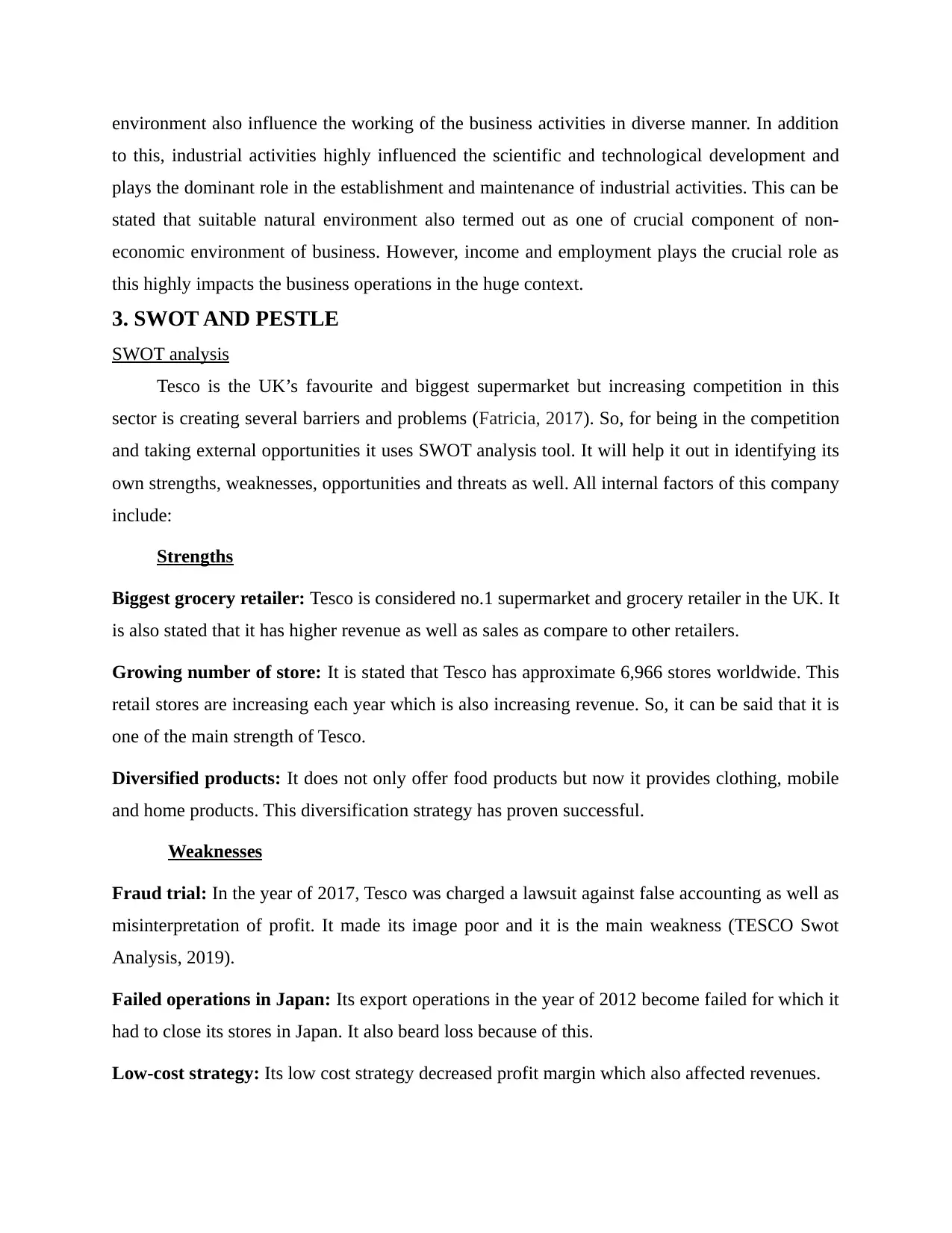
environment also influence the working of the business activities in diverse manner. In addition
to this, industrial activities highly influenced the scientific and technological development and
plays the dominant role in the establishment and maintenance of industrial activities. This can be
stated that suitable natural environment also termed out as one of crucial component of non-
economic environment of business. However, income and employment plays the crucial role as
this highly impacts the business operations in the huge context.
3. SWOT AND PESTLE
SWOT analysis
Tesco is the UK’s favourite and biggest supermarket but increasing competition in this
sector is creating several barriers and problems (Fatricia, 2017). So, for being in the competition
and taking external opportunities it uses SWOT analysis tool. It will help it out in identifying its
own strengths, weaknesses, opportunities and threats as well. All internal factors of this company
include:
Strengths
Biggest grocery retailer: Tesco is considered no.1 supermarket and grocery retailer in the UK. It
is also stated that it has higher revenue as well as sales as compare to other retailers.
Growing number of store: It is stated that Tesco has approximate 6,966 stores worldwide. This
retail stores are increasing each year which is also increasing revenue. So, it can be said that it is
one of the main strength of Tesco.
Diversified products: It does not only offer food products but now it provides clothing, mobile
and home products. This diversification strategy has proven successful.
Weaknesses
Fraud trial: In the year of 2017, Tesco was charged a lawsuit against false accounting as well as
misinterpretation of profit. It made its image poor and it is the main weakness (TESCO Swot
Analysis, 2019).
Failed operations in Japan: Its export operations in the year of 2012 become failed for which it
had to close its stores in Japan. It also beard loss because of this.
Low-cost strategy: Its low cost strategy decreased profit margin which also affected revenues.
to this, industrial activities highly influenced the scientific and technological development and
plays the dominant role in the establishment and maintenance of industrial activities. This can be
stated that suitable natural environment also termed out as one of crucial component of non-
economic environment of business. However, income and employment plays the crucial role as
this highly impacts the business operations in the huge context.
3. SWOT AND PESTLE
SWOT analysis
Tesco is the UK’s favourite and biggest supermarket but increasing competition in this
sector is creating several barriers and problems (Fatricia, 2017). So, for being in the competition
and taking external opportunities it uses SWOT analysis tool. It will help it out in identifying its
own strengths, weaknesses, opportunities and threats as well. All internal factors of this company
include:
Strengths
Biggest grocery retailer: Tesco is considered no.1 supermarket and grocery retailer in the UK. It
is also stated that it has higher revenue as well as sales as compare to other retailers.
Growing number of store: It is stated that Tesco has approximate 6,966 stores worldwide. This
retail stores are increasing each year which is also increasing revenue. So, it can be said that it is
one of the main strength of Tesco.
Diversified products: It does not only offer food products but now it provides clothing, mobile
and home products. This diversification strategy has proven successful.
Weaknesses
Fraud trial: In the year of 2017, Tesco was charged a lawsuit against false accounting as well as
misinterpretation of profit. It made its image poor and it is the main weakness (TESCO Swot
Analysis, 2019).
Failed operations in Japan: Its export operations in the year of 2012 become failed for which it
had to close its stores in Japan. It also beard loss because of this.
Low-cost strategy: Its low cost strategy decreased profit margin which also affected revenues.
Paraphrase This Document
Need a fresh take? Get an instant paraphrase of this document with our AI Paraphraser
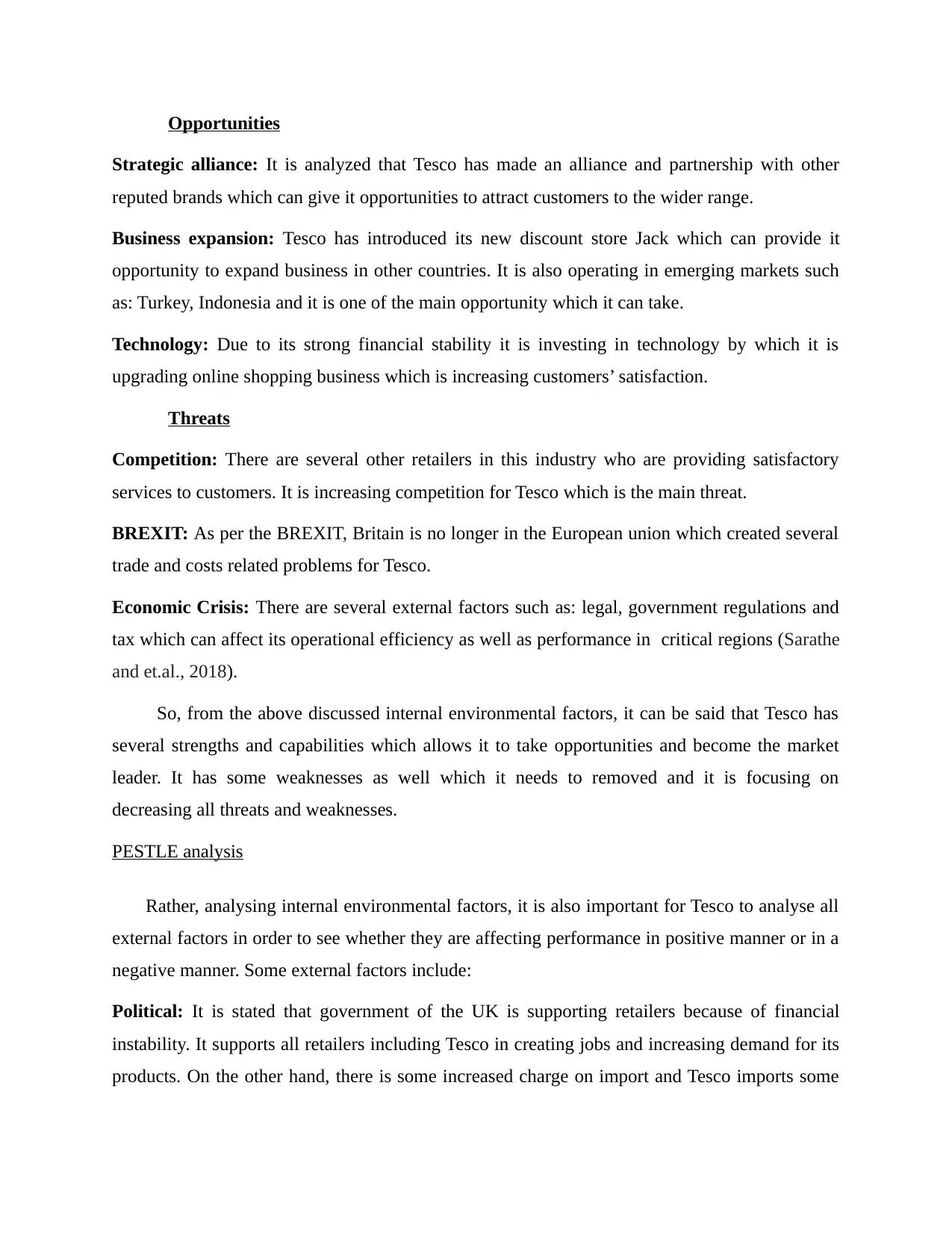
Opportunities
Strategic alliance: It is analyzed that Tesco has made an alliance and partnership with other
reputed brands which can give it opportunities to attract customers to the wider range.
Business expansion: Tesco has introduced its new discount store Jack which can provide it
opportunity to expand business in other countries. It is also operating in emerging markets such
as: Turkey, Indonesia and it is one of the main opportunity which it can take.
Technology: Due to its strong financial stability it is investing in technology by which it is
upgrading online shopping business which is increasing customers’ satisfaction.
Threats
Competition: There are several other retailers in this industry who are providing satisfactory
services to customers. It is increasing competition for Tesco which is the main threat.
BREXIT: As per the BREXIT, Britain is no longer in the European union which created several
trade and costs related problems for Tesco.
Economic Crisis: There are several external factors such as: legal, government regulations and
tax which can affect its operational efficiency as well as performance in critical regions (Sarathe
and et.al., 2018).
So, from the above discussed internal environmental factors, it can be said that Tesco has
several strengths and capabilities which allows it to take opportunities and become the market
leader. It has some weaknesses as well which it needs to removed and it is focusing on
decreasing all threats and weaknesses.
PESTLE analysis
Rather, analysing internal environmental factors, it is also important for Tesco to analyse all
external factors in order to see whether they are affecting performance in positive manner or in a
negative manner. Some external factors include:
Political: It is stated that government of the UK is supporting retailers because of financial
instability. It supports all retailers including Tesco in creating jobs and increasing demand for its
products. On the other hand, there is some increased charge on import and Tesco imports some
Strategic alliance: It is analyzed that Tesco has made an alliance and partnership with other
reputed brands which can give it opportunities to attract customers to the wider range.
Business expansion: Tesco has introduced its new discount store Jack which can provide it
opportunity to expand business in other countries. It is also operating in emerging markets such
as: Turkey, Indonesia and it is one of the main opportunity which it can take.
Technology: Due to its strong financial stability it is investing in technology by which it is
upgrading online shopping business which is increasing customers’ satisfaction.
Threats
Competition: There are several other retailers in this industry who are providing satisfactory
services to customers. It is increasing competition for Tesco which is the main threat.
BREXIT: As per the BREXIT, Britain is no longer in the European union which created several
trade and costs related problems for Tesco.
Economic Crisis: There are several external factors such as: legal, government regulations and
tax which can affect its operational efficiency as well as performance in critical regions (Sarathe
and et.al., 2018).
So, from the above discussed internal environmental factors, it can be said that Tesco has
several strengths and capabilities which allows it to take opportunities and become the market
leader. It has some weaknesses as well which it needs to removed and it is focusing on
decreasing all threats and weaknesses.
PESTLE analysis
Rather, analysing internal environmental factors, it is also important for Tesco to analyse all
external factors in order to see whether they are affecting performance in positive manner or in a
negative manner. Some external factors include:
Political: It is stated that government of the UK is supporting retailers because of financial
instability. It supports all retailers including Tesco in creating jobs and increasing demand for its
products. On the other hand, there is some increased charge on import and Tesco imports some
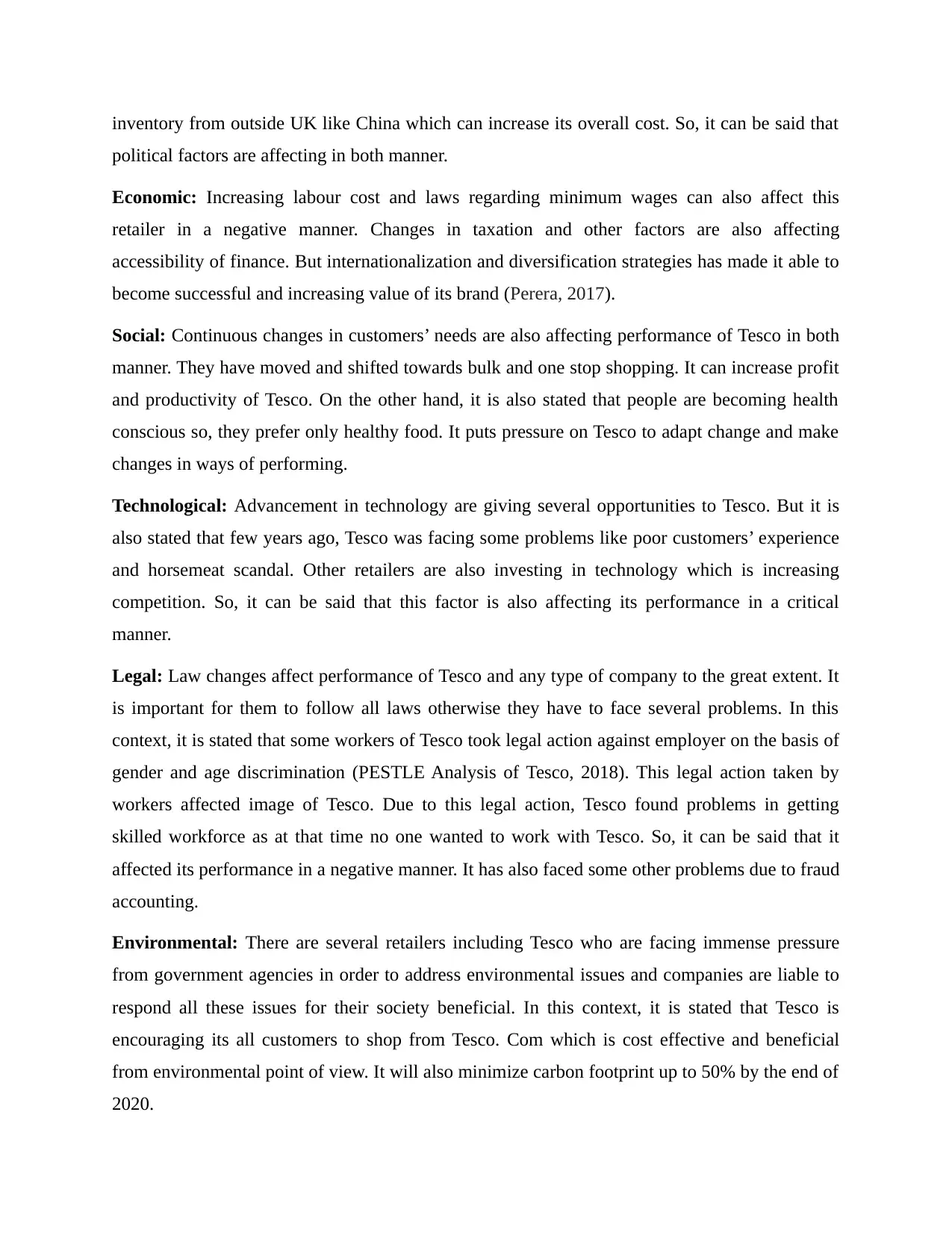
inventory from outside UK like China which can increase its overall cost. So, it can be said that
political factors are affecting in both manner.
Economic: Increasing labour cost and laws regarding minimum wages can also affect this
retailer in a negative manner. Changes in taxation and other factors are also affecting
accessibility of finance. But internationalization and diversification strategies has made it able to
become successful and increasing value of its brand (Perera, 2017).
Social: Continuous changes in customers’ needs are also affecting performance of Tesco in both
manner. They have moved and shifted towards bulk and one stop shopping. It can increase profit
and productivity of Tesco. On the other hand, it is also stated that people are becoming health
conscious so, they prefer only healthy food. It puts pressure on Tesco to adapt change and make
changes in ways of performing.
Technological: Advancement in technology are giving several opportunities to Tesco. But it is
also stated that few years ago, Tesco was facing some problems like poor customers’ experience
and horsemeat scandal. Other retailers are also investing in technology which is increasing
competition. So, it can be said that this factor is also affecting its performance in a critical
manner.
Legal: Law changes affect performance of Tesco and any type of company to the great extent. It
is important for them to follow all laws otherwise they have to face several problems. In this
context, it is stated that some workers of Tesco took legal action against employer on the basis of
gender and age discrimination (PESTLE Analysis of Tesco, 2018). This legal action taken by
workers affected image of Tesco. Due to this legal action, Tesco found problems in getting
skilled workforce as at that time no one wanted to work with Tesco. So, it can be said that it
affected its performance in a negative manner. It has also faced some other problems due to fraud
accounting.
Environmental: There are several retailers including Tesco who are facing immense pressure
from government agencies in order to address environmental issues and companies are liable to
respond all these issues for their society beneficial. In this context, it is stated that Tesco is
encouraging its all customers to shop from Tesco. Com which is cost effective and beneficial
from environmental point of view. It will also minimize carbon footprint up to 50% by the end of
2020.
political factors are affecting in both manner.
Economic: Increasing labour cost and laws regarding minimum wages can also affect this
retailer in a negative manner. Changes in taxation and other factors are also affecting
accessibility of finance. But internationalization and diversification strategies has made it able to
become successful and increasing value of its brand (Perera, 2017).
Social: Continuous changes in customers’ needs are also affecting performance of Tesco in both
manner. They have moved and shifted towards bulk and one stop shopping. It can increase profit
and productivity of Tesco. On the other hand, it is also stated that people are becoming health
conscious so, they prefer only healthy food. It puts pressure on Tesco to adapt change and make
changes in ways of performing.
Technological: Advancement in technology are giving several opportunities to Tesco. But it is
also stated that few years ago, Tesco was facing some problems like poor customers’ experience
and horsemeat scandal. Other retailers are also investing in technology which is increasing
competition. So, it can be said that this factor is also affecting its performance in a critical
manner.
Legal: Law changes affect performance of Tesco and any type of company to the great extent. It
is important for them to follow all laws otherwise they have to face several problems. In this
context, it is stated that some workers of Tesco took legal action against employer on the basis of
gender and age discrimination (PESTLE Analysis of Tesco, 2018). This legal action taken by
workers affected image of Tesco. Due to this legal action, Tesco found problems in getting
skilled workforce as at that time no one wanted to work with Tesco. So, it can be said that it
affected its performance in a negative manner. It has also faced some other problems due to fraud
accounting.
Environmental: There are several retailers including Tesco who are facing immense pressure
from government agencies in order to address environmental issues and companies are liable to
respond all these issues for their society beneficial. In this context, it is stated that Tesco is
encouraging its all customers to shop from Tesco. Com which is cost effective and beneficial
from environmental point of view. It will also minimize carbon footprint up to 50% by the end of
2020.
⊘ This is a preview!⊘
Do you want full access?
Subscribe today to unlock all pages.

Trusted by 1+ million students worldwide
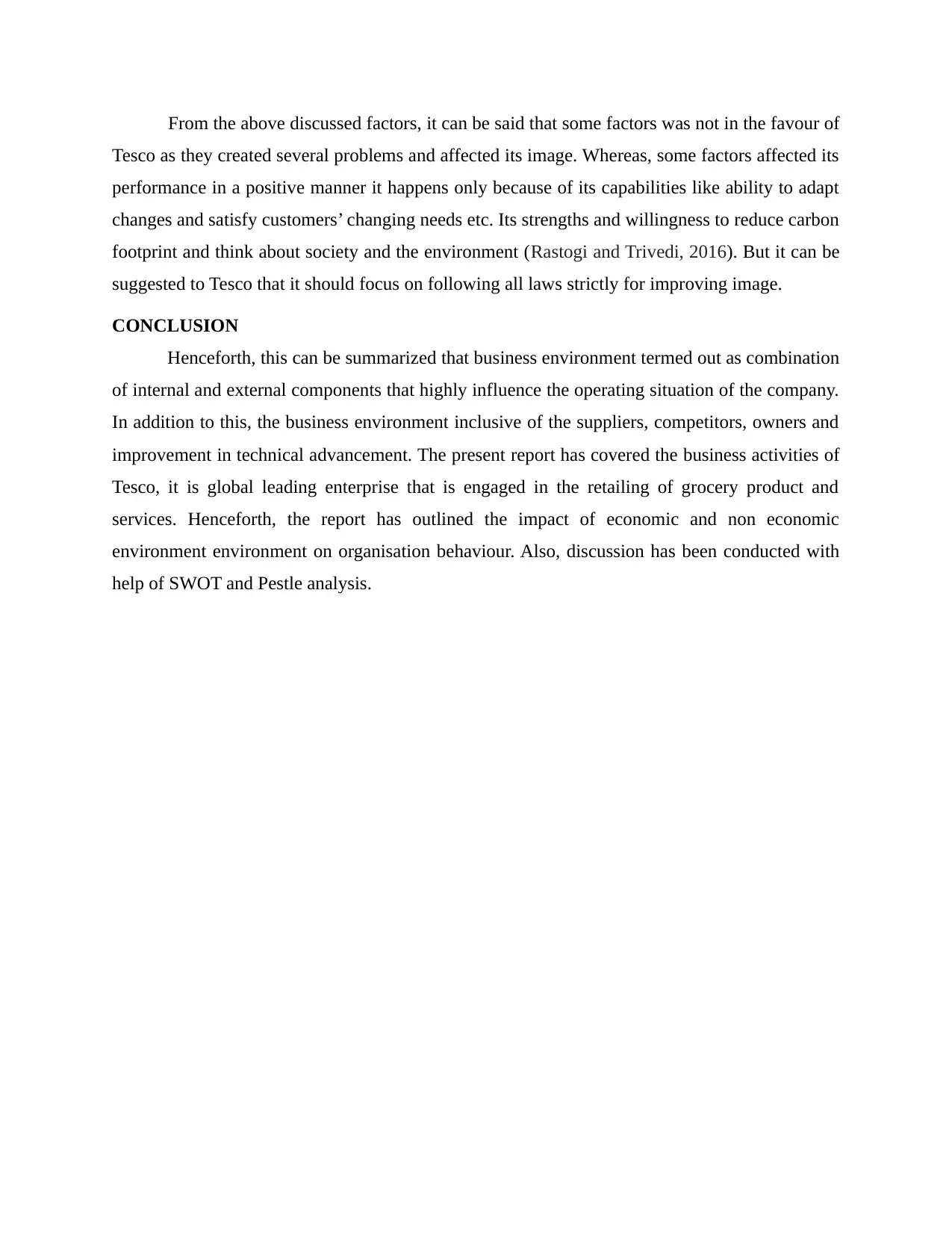
From the above discussed factors, it can be said that some factors was not in the favour of
Tesco as they created several problems and affected its image. Whereas, some factors affected its
performance in a positive manner it happens only because of its capabilities like ability to adapt
changes and satisfy customers’ changing needs etc. Its strengths and willingness to reduce carbon
footprint and think about society and the environment (Rastogi and Trivedi, 2016). But it can be
suggested to Tesco that it should focus on following all laws strictly for improving image.
CONCLUSION
Henceforth, this can be summarized that business environment termed out as combination
of internal and external components that highly influence the operating situation of the company.
In addition to this, the business environment inclusive of the suppliers, competitors, owners and
improvement in technical advancement. The present report has covered the business activities of
Tesco, it is global leading enterprise that is engaged in the retailing of grocery product and
services. Henceforth, the report has outlined the impact of economic and non economic
environment environment on organisation behaviour. Also, discussion has been conducted with
help of SWOT and Pestle analysis.
Tesco as they created several problems and affected its image. Whereas, some factors affected its
performance in a positive manner it happens only because of its capabilities like ability to adapt
changes and satisfy customers’ changing needs etc. Its strengths and willingness to reduce carbon
footprint and think about society and the environment (Rastogi and Trivedi, 2016). But it can be
suggested to Tesco that it should focus on following all laws strictly for improving image.
CONCLUSION
Henceforth, this can be summarized that business environment termed out as combination
of internal and external components that highly influence the operating situation of the company.
In addition to this, the business environment inclusive of the suppliers, competitors, owners and
improvement in technical advancement. The present report has covered the business activities of
Tesco, it is global leading enterprise that is engaged in the retailing of grocery product and
services. Henceforth, the report has outlined the impact of economic and non economic
environment environment on organisation behaviour. Also, discussion has been conducted with
help of SWOT and Pestle analysis.
Paraphrase This Document
Need a fresh take? Get an instant paraphrase of this document with our AI Paraphraser
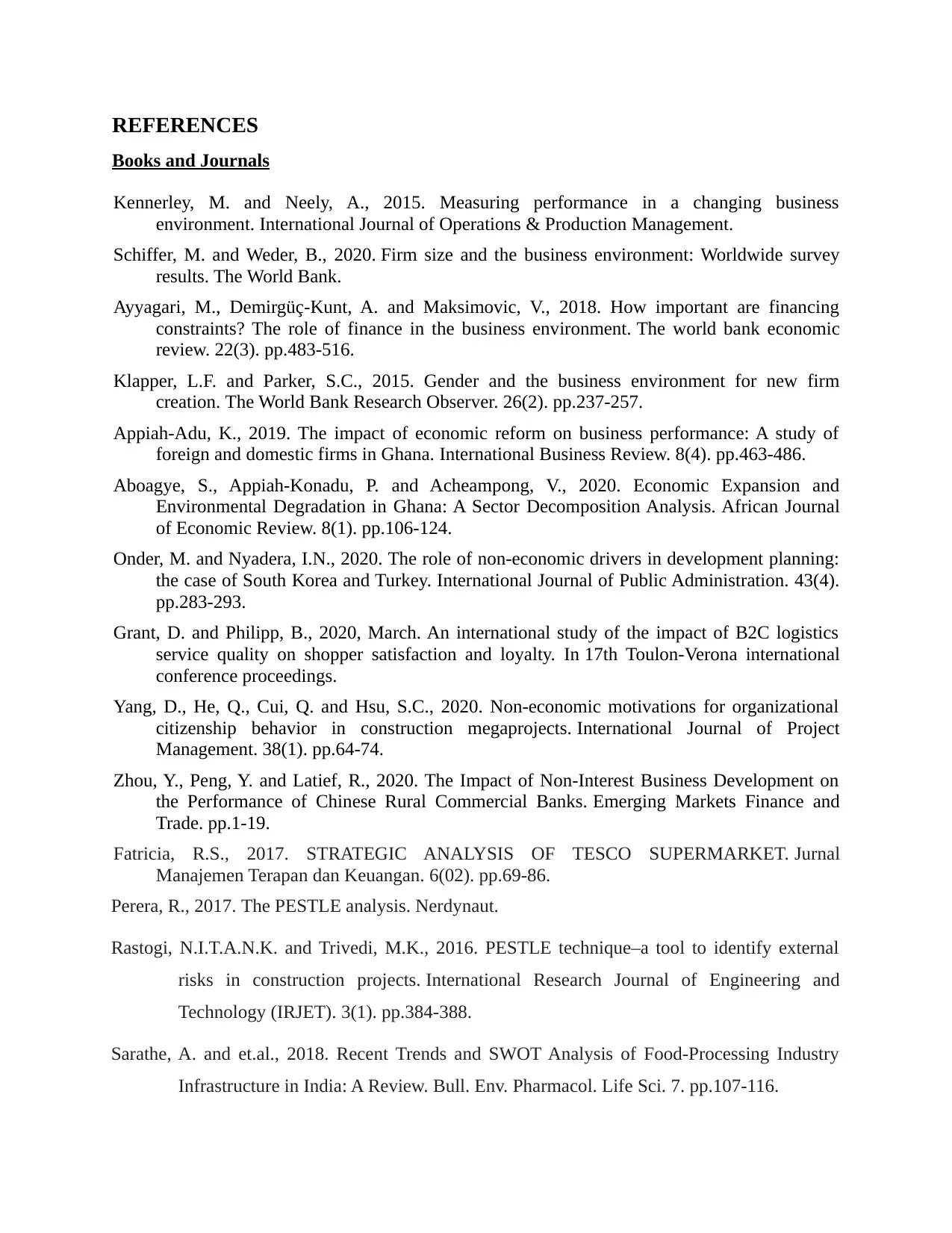
REFERENCES
Books and Journals
Kennerley, M. and Neely, A., 2015. Measuring performance in a changing business
environment. International Journal of Operations & Production Management.
Schiffer, M. and Weder, B., 2020. Firm size and the business environment: Worldwide survey
results. The World Bank.
Ayyagari, M., Demirgüç-Kunt, A. and Maksimovic, V., 2018. How important are financing
constraints? The role of finance in the business environment. The world bank economic
review. 22(3). pp.483-516.
Klapper, L.F. and Parker, S.C., 2015. Gender and the business environment for new firm
creation. The World Bank Research Observer. 26(2). pp.237-257.
Appiah-Adu, K., 2019. The impact of economic reform on business performance: A study of
foreign and domestic firms in Ghana. International Business Review. 8(4). pp.463-486.
Aboagye, S., Appiah-Konadu, P. and Acheampong, V., 2020. Economic Expansion and
Environmental Degradation in Ghana: A Sector Decomposition Analysis. African Journal
of Economic Review. 8(1). pp.106-124.
Onder, M. and Nyadera, I.N., 2020. The role of non-economic drivers in development planning:
the case of South Korea and Turkey. International Journal of Public Administration. 43(4).
pp.283-293.
Grant, D. and Philipp, B., 2020, March. An international study of the impact of B2C logistics
service quality on shopper satisfaction and loyalty. In 17th Toulon-Verona international
conference proceedings.
Yang, D., He, Q., Cui, Q. and Hsu, S.C., 2020. Non-economic motivations for organizational
citizenship behavior in construction megaprojects. International Journal of Project
Management. 38(1). pp.64-74.
Zhou, Y., Peng, Y. and Latief, R., 2020. The Impact of Non-Interest Business Development on
the Performance of Chinese Rural Commercial Banks. Emerging Markets Finance and
Trade. pp.1-19.
Fatricia, R.S., 2017. STRATEGIC ANALYSIS OF TESCO SUPERMARKET. Jurnal
Manajemen Terapan dan Keuangan. 6(02). pp.69-86.
Perera, R., 2017. The PESTLE analysis. Nerdynaut.
Rastogi, N.I.T.A.N.K. and Trivedi, M.K., 2016. PESTLE technique–a tool to identify external
risks in construction projects. International Research Journal of Engineering and
Technology (IRJET). 3(1). pp.384-388.
Sarathe, A. and et.al., 2018. Recent Trends and SWOT Analysis of Food-Processing Industry
Infrastructure in India: A Review. Bull. Env. Pharmacol. Life Sci. 7. pp.107-116.
Books and Journals
Kennerley, M. and Neely, A., 2015. Measuring performance in a changing business
environment. International Journal of Operations & Production Management.
Schiffer, M. and Weder, B., 2020. Firm size and the business environment: Worldwide survey
results. The World Bank.
Ayyagari, M., Demirgüç-Kunt, A. and Maksimovic, V., 2018. How important are financing
constraints? The role of finance in the business environment. The world bank economic
review. 22(3). pp.483-516.
Klapper, L.F. and Parker, S.C., 2015. Gender and the business environment for new firm
creation. The World Bank Research Observer. 26(2). pp.237-257.
Appiah-Adu, K., 2019. The impact of economic reform on business performance: A study of
foreign and domestic firms in Ghana. International Business Review. 8(4). pp.463-486.
Aboagye, S., Appiah-Konadu, P. and Acheampong, V., 2020. Economic Expansion and
Environmental Degradation in Ghana: A Sector Decomposition Analysis. African Journal
of Economic Review. 8(1). pp.106-124.
Onder, M. and Nyadera, I.N., 2020. The role of non-economic drivers in development planning:
the case of South Korea and Turkey. International Journal of Public Administration. 43(4).
pp.283-293.
Grant, D. and Philipp, B., 2020, March. An international study of the impact of B2C logistics
service quality on shopper satisfaction and loyalty. In 17th Toulon-Verona international
conference proceedings.
Yang, D., He, Q., Cui, Q. and Hsu, S.C., 2020. Non-economic motivations for organizational
citizenship behavior in construction megaprojects. International Journal of Project
Management. 38(1). pp.64-74.
Zhou, Y., Peng, Y. and Latief, R., 2020. The Impact of Non-Interest Business Development on
the Performance of Chinese Rural Commercial Banks. Emerging Markets Finance and
Trade. pp.1-19.
Fatricia, R.S., 2017. STRATEGIC ANALYSIS OF TESCO SUPERMARKET. Jurnal
Manajemen Terapan dan Keuangan. 6(02). pp.69-86.
Perera, R., 2017. The PESTLE analysis. Nerdynaut.
Rastogi, N.I.T.A.N.K. and Trivedi, M.K., 2016. PESTLE technique–a tool to identify external
risks in construction projects. International Research Journal of Engineering and
Technology (IRJET). 3(1). pp.384-388.
Sarathe, A. and et.al., 2018. Recent Trends and SWOT Analysis of Food-Processing Industry
Infrastructure in India: A Review. Bull. Env. Pharmacol. Life Sci. 7. pp.107-116.
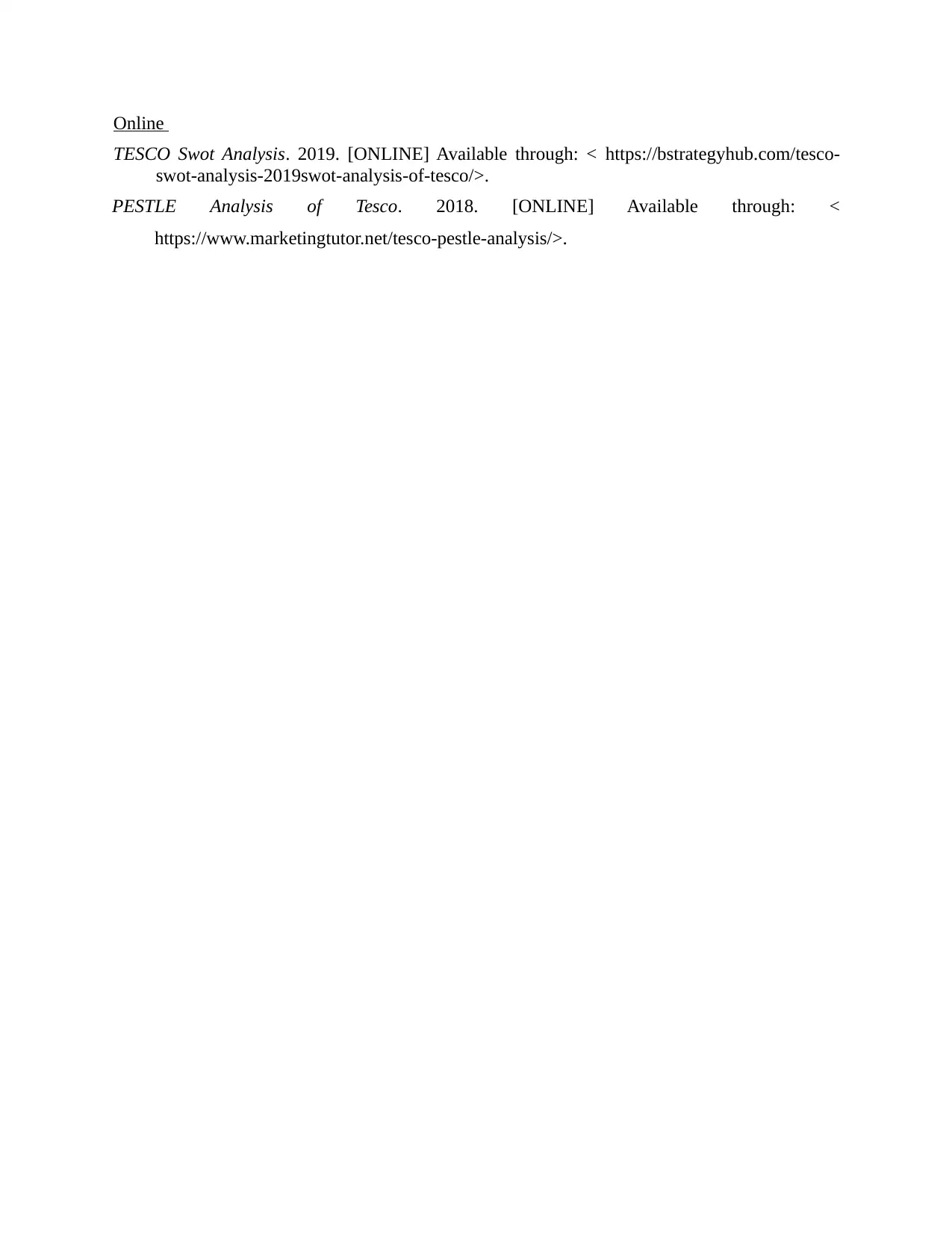
Online
TESCO Swot Analysis. 2019. [ONLINE] Available through: < https://bstrategyhub.com/tesco-
swot-analysis-2019swot-analysis-of-tesco/>.
PESTLE Analysis of Tesco. 2018. [ONLINE] Available through: <
https://www.marketingtutor.net/tesco-pestle-analysis/>.
TESCO Swot Analysis. 2019. [ONLINE] Available through: < https://bstrategyhub.com/tesco-
swot-analysis-2019swot-analysis-of-tesco/>.
PESTLE Analysis of Tesco. 2018. [ONLINE] Available through: <
https://www.marketingtutor.net/tesco-pestle-analysis/>.
⊘ This is a preview!⊘
Do you want full access?
Subscribe today to unlock all pages.

Trusted by 1+ million students worldwide
1 out of 12
Related Documents
Your All-in-One AI-Powered Toolkit for Academic Success.
+13062052269
info@desklib.com
Available 24*7 on WhatsApp / Email
![[object Object]](/_next/static/media/star-bottom.7253800d.svg)
Unlock your academic potential
Copyright © 2020–2025 A2Z Services. All Rights Reserved. Developed and managed by ZUCOL.





